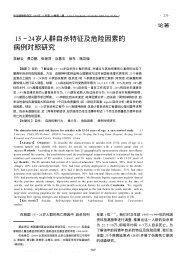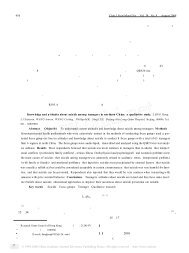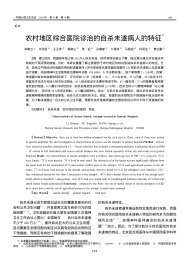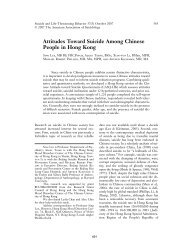Interventions for Suicide Survivors: A Review of the Literature
Interventions for Suicide Survivors: A Review of the Literature
Interventions for Suicide Survivors: A Review of the Literature
You also want an ePaper? Increase the reach of your titles
YUMPU automatically turns print PDFs into web optimized ePapers that Google loves.
Jordan and McMenamy 341<br />
men and women to intervention. There is clude deaths that are sudden and unexpected,<br />
growing evidence that men and women may violent, and/or <strong>the</strong> result <strong>of</strong> human activity<br />
use different coping styles to deal with loss (Stroebe & Schut, 2001). All <strong>of</strong> this suggests<br />
(Martin & Doka, 2000; Murphy, Johnson, & that survivors may be more likely to benefit<br />
Weber, 2002). The typical structure <strong>of</strong> sup- from <strong>for</strong>mal interventions than <strong>the</strong> general<br />
port interventions (e.g., self-disclosure and<br />
sharing <strong>of</strong> feelings) may be less effective, or<br />
perhaps even deleterious, <strong>for</strong> people with an<br />
population <strong>of</strong> bereaved persons.<br />
instrumental and more avoidant orientation SUICIDE SPECIFIC<br />
to coping, which is generally more characteristic<br />
<strong>of</strong> males. Again, this would tend to wash<br />
INTERVENTIONS<br />
out positive effects in studies <strong>of</strong> bereavement Turning to studies <strong>of</strong> suicide specific in-<br />
interventions if data are not analyzed sepatervention programs, a search was conducted<br />
rately by gender. <strong>of</strong> <strong>the</strong> PsychLit and <strong>the</strong> <strong>Suicide</strong> In<strong>for</strong>mation<br />
Lastly, it is quite possible that <strong>the</strong> typi- and Education databases <strong>for</strong> studies related<br />
cal bereavement intervention is significantly to suicide bereavement and intervention/<br />
below <strong>the</strong> “<strong>the</strong>rapeutic dosage” level needed treatment. While numerous positive descrip-<br />
to produce a desirable effect. Most research tions <strong>of</strong> groups or programs <strong>for</strong> survivors ex-<br />
intervention protocols involve a relatively ist (Apel & Wrobleski, 1987; Freeman, 1991;<br />
small number <strong>of</strong> treatment sessions (usually Juhnke & Sh<strong>of</strong>fner, 1999), only a handful <strong>of</strong><br />
8 to 12), typically <strong>of</strong>fered shortly after <strong>the</strong> empirical studies have been conducted to asloss<br />
and in rapid (usually weekly) succession. sess <strong>the</strong> effectiveness <strong>of</strong> <strong>the</strong>se programs. Given<br />
In contrast, <strong>the</strong>re is evidence that <strong>for</strong> some <strong>the</strong> dearth <strong>of</strong> methodologically rigorous repeople<br />
bereavement, particularly after trau- search, we have included in this review any<br />
matic loss, is a long-term adaptational pro- study that involved some type <strong>of</strong> objective<br />
cess, one that may even become more diffi- evaluation <strong>of</strong> <strong>the</strong> effectiveness <strong>of</strong> <strong>the</strong> intercult<br />
in <strong>the</strong> second and third years (Murphy, vention, regardless <strong>of</strong> <strong>the</strong> utilization <strong>of</strong> con-<br />
2000; Murphy, Johnson, Wu, Fan, & Lohan, trol groups or random assignment. Due to<br />
2003; Wortman & Silver, 2001). Longer- space limitations, <strong>the</strong> review was limited to<br />
term support may <strong>the</strong>re<strong>for</strong>e be needed after <strong>for</strong>mal interventions with adults. Fur<strong>the</strong>r<strong>the</strong>se<br />
types <strong>of</strong> losses. Indeed, some <strong>of</strong> <strong>the</strong> remore, while interventions targeting organizaviews<br />
have suggested that bereavement in- tions ra<strong>the</strong>r than individuals or families (e.g.,<br />
terventions might be more effective when postventions in business or hospital settings)<br />
<strong>of</strong>fered later, ra<strong>the</strong>r than earlier, after <strong>the</strong> would be eligible <strong>for</strong> inclusion, we were undeath.<br />
This would also coincide with <strong>the</strong> able to locate any studies that included objec-<br />
survey data from suicide survivors indicating tive attempts to measure <strong>the</strong> impact <strong>of</strong> such<br />
a perceived need <strong>for</strong> longer-term support interventions.<br />
(Dyregrov, 2002). Farberow (1992) conducted a controlled<br />
Of a more hopeful nature are <strong>the</strong> find- study <strong>of</strong> 60 participants in an 8-week, semiings<br />
that interventions <strong>for</strong> high-risk and/or structured group support program <strong>for</strong> survihigh<br />
distress mourners are generally more efvors. The control group consisted <strong>of</strong> 22 perficacious.<br />
It appears that interventions have sons who had signed up <strong>for</strong> <strong>the</strong> program and/<br />
<strong>the</strong>ir greatest impact on those who are ei<strong>the</strong>r or attended one session, and <strong>the</strong>n dropped<br />
in high-risk categories (e.g., suicide survi- out. Participants were asked to estimate <strong>the</strong><br />
vors), or who are specifically seeking help be- intensity <strong>of</strong> nine different feelings (anger, grief,<br />
cause <strong>the</strong>y show high levels <strong>of</strong> distress at <strong>the</strong> guilt, etc.) at three points: time <strong>of</strong> <strong>the</strong> death<br />
start <strong>of</strong> <strong>the</strong> intervention. Many <strong>of</strong> <strong>the</strong> factors (retrospectively evaluated), pre-intervention,<br />
that are present in most, if not all, suicides and immediately post-intervention. Results<br />
are also relatively well established as risk fac- indicated that <strong>the</strong> treatment group had sigtors<br />
<strong>for</strong> complicated bereavement. These in- nificantly higher levels <strong>of</strong> grief, shame, and

















